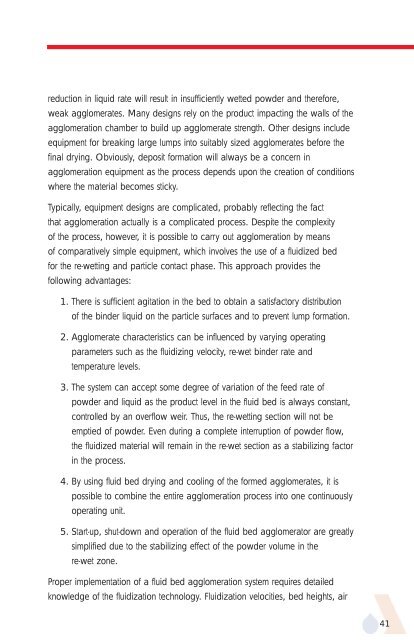APV Dryer Handbook - Umbc
APV Dryer Handbook - Umbc
APV Dryer Handbook - Umbc
You also want an ePaper? Increase the reach of your titles
YUMPU automatically turns print PDFs into web optimized ePapers that Google loves.
eduction in liquid rate will result in insufficiently wetted powder and therefore,<br />
weak agglomerates. Many designs rely on the product impacting the walls of the<br />
agglomeration chamber to build up agglomerate strength. Other designs include<br />
equipment for breaking large lumps into suitably sized agglomerates before the<br />
final drying. Obviously, deposit formation will always be a concern in<br />
agglomeration equipment as the process depends upon the creation of conditions<br />
where the material becomes sticky.<br />
Typically, equipment designs are complicated, probably reflecting the fact<br />
that agglomeration actually is a complicated process. Despite the complexity<br />
of the process, however, it is possible to carry out agglomeration by means<br />
of comparatively simple equipment, which involves the use of a fluidized bed<br />
for the re-wetting and particle contact phase. This approach provides the<br />
following advantages:<br />
1. There is sufficient agitation in the bed to obtain a satisfactory distribution<br />
of the binder liquid on the particle surfaces and to prevent lump formation.<br />
2. Agglomerate characteristics can be influenced by varying operating<br />
parameters such as the fluidizing velocity, re-wet binder rate and<br />
temperature levels.<br />
3. The system can accept some degree of variation of the feed rate of<br />
powder and liquid as the product level in the fluid bed is always constant,<br />
controlled by an overflow weir. Thus, the re-wetting section will not be<br />
emptied of powder. Even during a complete interruption of powder flow,<br />
the fluidized material will remain in the re-wet section as a stabilizing factor<br />
in the process.<br />
4. By using fluid bed drying and cooling of the formed agglomerates, it is<br />
possible to combine the entire agglomeration process into one continuously<br />
operating unit.<br />
5. Start-up, shut-down and operation of the fluid bed agglomerator are greatly<br />
simplified due to the stabilizing effect of the powder volume in the<br />
re-wet zone.<br />
Proper implementation of a fluid bed agglomeration system requires detailed<br />
knowledge of the fluidization technology. Fluidization velocities, bed heights, air<br />
41











